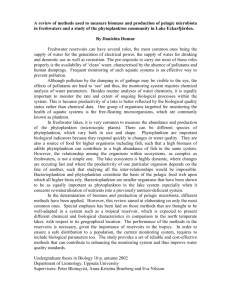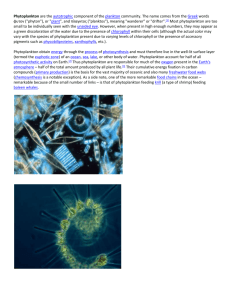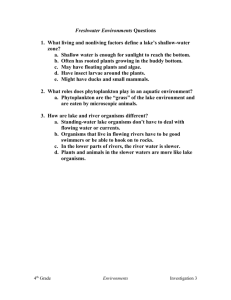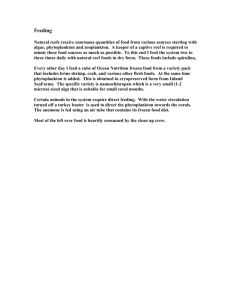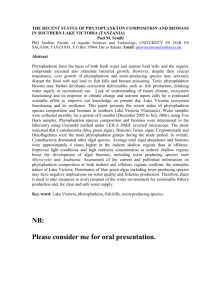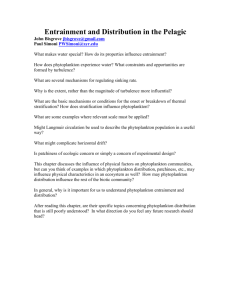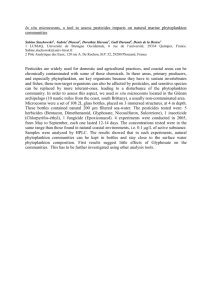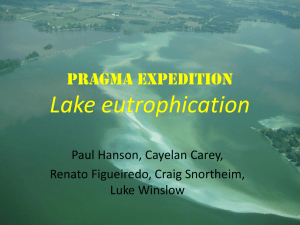Document 10999175
advertisement
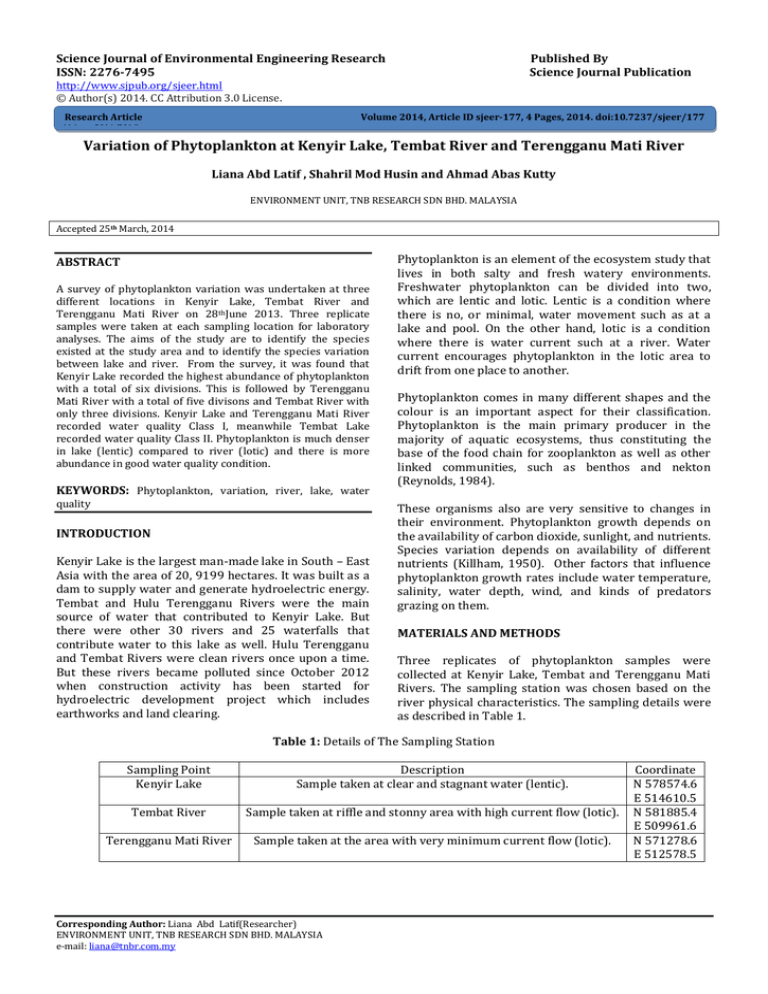
Science Journal of Environmental Engineering Research ISSN: 2276-7495 Published By Science Journal Publication http://www.sjpub.org/sjeer.html © Author(s) 2014. CC Attribution 3.0 License. Research Article Volume 2014, Article ID sjeer-177, 4 Pages, 2014. doi:10.7237/sjeer/177 Volume 2014 (2014) Variation of Phytoplankton at Kenyir Lake, Tembat River and Terengganu Mati River Liana Abd Latif , Shahril Mod Husin and Ahmad Abas Kutty ENVIRONMENT UNIT, TNB RESEARCH SDN BHD. MALAYSIA Accepted 25th March, 2014 ABSTRACT A survey of phytoplankton variation was undertaken at three different locations in Kenyir Lake, Tembat River and Terengganu Mati River on 28thJune 2013. Three replicate samples were taken at each sampling location for laboratory analyses. The aims of the study are to identify the species existed at the study area and to identify the species variation between lake and river. From the survey, it was found that Kenyir Lake recorded the highest abundance of phytoplankton with a total of six divisions. This is followed by Terengganu Mati River with a total of five divisons and Tembat River with only three divisions. Kenyir Lake and Terengganu Mati River recorded water quality Class I, meanwhile Tembat Lake recorded water quality Class II. Phytoplankton is much denser in lake (lentic) compared to river (lotic) and there is more abundance in good water quality condition. KEYWORDS: Phytoplankton, variation, river, lake, water quality INTRODUCTION Kenyir Lake is the largest man-made lake in South – East Asia with the area of 20, 9199 hectares. It was built as a dam to supply water and generate hydroelectric energy. Tembat and Hulu Terengganu Rivers were the main source of water that contributed to Kenyir Lake. But there were other 30 rivers and 25 waterfalls that contribute water to this lake as well. Hulu Terengganu and Tembat Rivers were clean rivers once upon a time. But these rivers became polluted since October 2012 when construction activity has been started for hydroelectric development project which includes earthworks and land clearing. Phytoplankton is an element of the ecosystem study that lives in both salty and fresh watery environments. Freshwater phytoplankton can be divided into two, which are lentic and lotic. Lentic is a condition where there is no, or minimal, water movement such as at a lake and pool. On the other hand, lotic is a condition where there is water current such at a river. Water current encourages phytoplankton in the lotic area to drift from one place to another. Phytoplankton comes in many different shapes and the colour is an important aspect for their classification. Phytoplankton is the main primary producer in the majority of aquatic ecosystems, thus constituting the base of the food chain for zooplankton as well as other linked communities, such as benthos and nekton (Reynolds, 1984). These organisms also are very sensitive to changes in their environment. Phytoplankton growth depends on the availability of carbon dioxide, sunlight, and nutrients. Species variation depends on availability of different nutrients (Killham, 1950). Other factors that influence phytoplankton growth rates include water temperature, salinity, water depth, wind, and kinds of predators grazing on them. MATERIALS AND METHODS Three replicates of phytoplankton samples were collected at Kenyir Lake, Tembat and Terengganu Mati Rivers. The sampling station was chosen based on the river physical characteristics. The sampling details were as described in Table 1. Table 1: Details of The Sampling Station Sampling Point Kenyir Lake Description Sample taken at clear and stagnant water (lentic). Tembat River Sample taken at riffle and stonny area with high current flow (lotic). Terengganu Mati River Sample taken at the area with very minimum current flow (lotic). Corresponding Author: Liana Abd Latif(Researcher) ENVIRONMENT UNIT, TNB RESEARCH SDN BHD. MALAYSIA e-mail: liana@tnbr.com.my Coordinate N 578574.6 E 514610.5 N 581885.4 E 509961.6 N 571278.6 E 512578.5 Scie nce Journa l of Env i ronme n ta l Engine e ri ng Re se a rch Phytoplankton samples were collected using plankton net with a mesh size of 35µm. The net is placed horizontally at a depth 0.5 -1.0 m below water surface for 5 minutes. Then, 100ml of phytoplankton sample was collected by a bucket and transferred to plastic sterilized sampling bottle. Few drops of formalin were put in the samples for preservation. At the same time, the temperature, pH, dissolved oxygen (DO), conductivity, turbidity were recorded using a portable YSI Probe Meter. Water samples also were taken and brought to the laboratory for BOD, COD, nitrate, nitrite, phosphate, ammonia and TSS analysis. The phytoplankton samples also were brought to laboratory for analyses and identification. Phytoplankton samples were examined under a microscope model Nikon Eclipse E200 and a camera model Nikon DS-Fi1 with NIS-Element D 3.2 64-bit software. The phytoplankton samples were analyzed to determine the Diversity Index, Evenness Index and Margalef Index by using softwares MVSP and PAST. RESULTS AND DISCUSSION Water Quality As presented in Table 2, Terengganu Mati River and Kenyir Lake were classified under water quality Class I. Meanwhile Tembat River was classified under water quality Class II. This showed that Terengganu Mati River and Kenyir Lake had better water quality than Tembat River. Highest temperature recorded was 28.42ºC at Terengganu Mati River. The lowest temperature recorded was 24.24 ºC at Tembat River. The optimum temperature for algal growth in aquatic ecosystem is between 25 – 40 ºC (Smith, 1950). (ISSN : 2276 -7495) P a g e |2 Temperature plays the main role in influencing phytoplankton density (Unni and Pawar, 2000). Temperature also plays important role in controlling the physiology changes and growth of phytoplankton (Moisan et.al, 2002) . Kenyir Lake recorded the lowest pH (acidic) as equal to 5.89. Low pH can only be found in natural water with high organic substances (Wetzel, 1983)[6]. Dissolved oxygen (DO) ranged between 61.49 and 85.3%. The concentration of DO also depends on temperature and atmospheric pressure. High concentration of ion also caused a decrease in DO percentage in water (Umaly and Cuvin, 1988). Conductivity ranged between 21.30 and 78.8 S/cm. The conductivity is related to concentrations of sulphates and nitrate ions (Mohammad et.al, 2007). Meanwhile, turbidity ranged from 12.58 to 35.21 NTU. Total suspended solids (TSS) ranged between 9.8 to 28.2 mg/l. Even though TSS is not toxic, but sedimentation is able to create many problems once entering water bodies (Ahmad and Ahmad, 2007). From the results, it is shown that Kenyir Lake is less turbid as it has low TSS compared to Tembat River and Terengganu Mati River. This is due to construction works that took place in the neighborhood of these rivers. Phosphate ranged from 0.02 to 0.18 mg/l. Nitrite ranged from 0.03 to 0.1 mg/l and nitrate ranged from 0.06 to 0.6 mg/l. Meanwhile ammonia ranged between 0.02 and 0.1 mg/l. Phytoplankton, like land plants, require nutrients such as nitrate, phosphate, silicate, and calcium at various levels depending on the species. Some phytoplankton can fix nitrogen and can grow in areas where nitrate concentrations are low. Nitrogen is needed in protein and pigment synthesis for phytoplankton (Prescott, 1968). How to Cite this Article: Liana Abd Latif , Shahril Mod Husin and Ahmad Abas Kutty, "Variation of Phytoplankton at Kenyir Lake, Tembat River and2 Terengganu Mati River", Science Journal of Environmental Engineering Research, Volume 2014, Article ID sjeer-177, 4 Pages, 2014. doi:10.7237/sjeer/177 Scie nce Journa l of Env i ronme n ta l Engine e ri ng Re se a rch (ISSN : 2276 -7495) P a g e |3 Table 2: Water Quality Measurements Temperature (ºC) pH DO (%) Conductivity ( S/cm) Turbidity (NTU) TSS (mg/l) BOD (mg/l) COD (mg/l) Phosphate (mg/l) NO2 (mg/l) NO3 (mg/l) NH3N (mg/l) WQI Class Kenyir Lake 27.50 5.89 85.30 78.80 12.58 9.80 0.88 3.10 0.18 0.10 0.06 0.02 94 I Tembat River 24.24 6.28 61.49 21.30 23.37 22.17 0.97 5.47 0.02 0.03 0.11 0.05 87 II Variation of Phytoplankton Figure 1 and Table 3 show that Kenyir Lake recorded the highest abundance of phytoplankton. Overall 6 divisions of phytoplankton were found at Kenyir Lake with a total of 79 species. Chlorophyta (65.81%) was the major division and Cosmarium cucumis was the dominant species. Other divisons found were Pyrrophyta (20.01%), Cyanophyta (9.41%), Chrysophyta (2.08%), Bacillariophyta (1.91%), and Euglenophyta (0.77%). Meanwhile only 3 divisions were found at Tembat River with a total of 76 species. Chlorophyta and Bacillariophyta were distributed equally (49.68%) and Eunotia sp. was the dominant species. Another 0.64% was represented by Cyanophyta. There were 41 species found at Terengganu Mati River with a total of 5 divisions. Chlorophyta (58.85%) was the major division and Tetraedron sp. was the dominant species. The rest were represented by Bacillariophyta (31.42%), Cyanophyta (6.64%), Chrysophyta (1.77%) and Pyrrophyta (1.33%). Phytoplankton is easily sampled in high quantity at the lake compared to the river. The lake acts as a basin where phytoplankton from other Terengganu Mati River 28.42 6.76 81.20 45.40 35.21 28.20 0.86 3.00 0.10 0.10 0.60 0.10 92 I related rivers accumulate. Stagnant water of the lake (lentic) caused phytoplankton to assemble within the area compared to phytoplankton in the river (lotic) that are easily drifted by the water current. Pigment composition of phytoplankton depends by sunlight quality and nutrient availability (Chapman and Chapman, 1962). The pigment composition differs between other divisions making this characteristic a very important one in classification (Bellinger, 1980). Kenyir Lake is a more open area compared to Tembat River and Terengganu Mati River. It is surrounded by rainforest, thus the possibility of sunlight to penetrate the water body is high. The availability of sunlight enhanced phytoplankton growth in the lake. Phytoplankton species like Euglena, Osillatoria, Chlamydomonas, Scenedesmus, Chorella and Stigeoclonium are bioindicators for water pollution (Palmer, 1959).. Meanwhile the appearance of Euglena and Phacus is due to high content of organic matters in the water body (Sze, 1986 and Tang, 2001). Absence of Euglenophyta at Tembat River and Terengganu Mati River means that those rivers were still in good condition. How to Cite this Article: Liana Abd Latif , Shahril Mod Husin and Ahmad Abas Kutty, "Variation of Phytoplankton at Kenyir Lake, Tembat River and3 Terengganu Mati River", Science Journal of Environmental Engineering Research, Volume 2014, Article ID sjeer-177, 4 Pages, 2014. doi:10.7237/sjeer/177 Scie nce Journa l of Env i ronme n ta l Engine e ri ng Re se a rch (ISSN : 2276 -7495) P a g e |4 Fig.1. Abundance of phytoplankton at Kenyir Lake, Tembat River and Terengganu Mati River. Table 3: Species List (A=Kenyir Lake; B=Tembat River; C=Terenggani Mati River) Division Species A B + + + + + + + + + + + + + + + + + + + + + + + + + + + + + + - + + + + + + + + + + + + C Bacillariophyta Achnanthes sp.1 Achnanthes sp.2 Caloneissilicula Coscinodiscussp.1 Coscinodiscus sp.2 Coscinodiscussp.3 Coscinodiscus sp.4 Cyclotella sp. Cymbellacistula Cymbella sp. Diatomaelongatum Diatoma sp. Eunotia sp. Fragilariajavanica Fragilariacrotonensis Fragilariacapucina Fragilaria sp.1 Fragilariasp.2 Fragilaria sp.3 Fragilariasp.4 Frustulia sp.1 Frustulia sp.2 Gyrosigma sp. Navicularhynchocephala Naviculasubtilissima Naviculasp.1 Navicula sp.2 Navicula sp.3 Neidium affine Nitzschia sp. Pinnulariasplendida Pinnulariatabellaria Pinnularia sp.1 Pinnularia sp.2 Pinnulariasp.3 + + + + + + + + + + + + + + - How to Cite this Article: Liana Abd Latif , Shahril Mod Husin and Ahmad Abas Kutty, "Variation of Phytoplankton at Kenyir Lake, Tembat River and4 Terengganu Mati River", Science Journal of Environmental Engineering Research, Volume 2014, Article ID sjeer-177, 4 Pages, 2014. doi:10.7237/sjeer/177 Scie nce Journa l of Env i ronme n ta l Engine e ri ng Re se a rch Chlorophyta (ISSN : 2276 -7495) P a g e |5 Surirellacapronii Surirellaelegans Surirellalinearis Surirellarobusta Synedra ulna Synedra sp. Tabellaria sp.1 Tabellariasp.2 + - + + + + + + + + + + + + - Arthrodesmussp.1 Arthrodesmus sp.2 Arthrodesmus sp.3 Arthrodesmus sp.4 Arthrodesmus sp.5 Arthrodesmus sp.6 Arthrodesmus sp.7 Binucleariatatrana Chodatellalongiseta Chodatellaquadriseta Closteriumdianae Clostriumloefgrenii Closteriumkuetzingii Closterium sp.1 Closteriumsp.2 Closterium sp.3 Closterium sp.4 Closterium sp.5 Closterium sp.6 Closterium sp.7 Cosmariumbioculatum Cosmariumcucumis Cosmariumportianum Cosmariumpachydermum Cosmarium sp.1 Cosmarium sp.2 Cosmarium sp.3 .Cosmarium sp.4 Cosmarium sp.5 Cosmarium sp.6 Cosmarium sp.7 Cosmarium sp.8 Cosmarium sp.9 Cosmarium sp.10 Cosmarium sp.11 Desmidiumcoarctatum Desmidium sp. Dictyosphaerium sp. Docidium sp. Eudorina Gonatozygonbrebissonii Gonatozygonkinahanii Gonatozygonmonotaenium Gonatozygonsp. Hyalotheca sp. Kirchneriellaelongata Micrasterias sp.1 Micrasteriassp.2 Mougeotia sp. Pleodorinacalifornica Pleurotaenium sp. Spirogyra sp. + + + + + + + + + + + + + + + + + + + + + + - + + + + + + + + + + + + + + + + + + + + + + + + + + + + + + + + + + + + + + + + + + + + + + + + - How to Cite this Article: Liana Abd Latif , Shahril Mod Husin and Ahmad Abas Kutty, "Variation of Phytoplankton at Kenyir Lake, Tembat River and5 Terengganu Mati River", Science Journal of Environmental Engineering Research, Volume 2014, Article ID sjeer-177, 4 Pages, 2014. doi:10.7237/sjeer/177 Scie nce Journa l of Env i ronme n ta l Engine e ri ng Re se a rch Chrysophyta Cyanophyta Euglenophyta Pyrrophyta (ISSN : 2276 -7495) P a g e |6 Spondylosiumellipticum Staurastrumgracile Staurastrumhexacerum Staurastrumleptocladum Staurastrumratulas Staurastrum sp.1 Staurastrum sp.2 Staurastrum sp.3 Staurastrum sp.4 Staurastrum sp.5 Staurastrum sp.6 Staurastrum sp.7 Staurastrum sp.8 Staurastrum sp.9 Staurastrum sp.10 Staurastrum sp.11 Staurastrum sp.12 Staurastrum sp.13 Staurastrumsp.14 Staurastrum sp.15 Staurastrum sp.16 Staurastrum sp.17 Tetraedron sp.1 Tetraedronsp.2 Zygnemaamericana Zygnemachlaybeospermum + + + + + + + + + + + + + + + + + + + + + + + + - + + + + + + - Centritractusbelanophorus Centritractus sp. Dinorbryonsociale Synura sp. Gleotrichiasp.1 Gleotrichia sp.2 Oscillatoriasp. Euglena acus Euglena sp. Euglena oblanga Phacuslongicauda Phacussp. Trachelomonasarmata Ceratiumhirundinella Ceratium sp.1 Ceratium sp.2 Glenodiniumpalustrum Glenodinium sp. Peridiniumpusillum Peridiniumwisconsine Peridinium sp. + + + + + + + + + + + + + + + + + + + - + + + + - How to Cite this Article: Liana Abd Latif , Shahril Mod Husin and Ahmad Abas Kutty, "Variation of Phytoplankton at Kenyir Lake, Tembat River and6 Terengganu Mati River", Science Journal of Environmental Engineering Research, Volume 2014, Article ID sjeer-177, 4 Pages, 2014. doi:10.7237/sjeer/177 Scie nce Journa l of Env i ronme n ta l Engine e ri ng Re se a rch (ISSN : 2276 -7495) P a g e |7 According to Table 4, Kenyir Lake recorded highest phytoplankton density reaching 5144 individual/ml. However, Tembat River is more diverse compared to Kenyir Lake and Terengganu Mati River. However, the diversity not only depends on the total number of individuals found at each sampling station, but it depends on the suitability of the species itself to survive in certain water condition. The serious pollution will affect the number of species and population The species evenness and richness also was highest at evenness (Patrick, 1948). Certain species become Tembat River. The diversity of community depends on dominant at a polluted area (Piirsoo, 2001). This two factors which are the species number and the characteristic is very important in determining the evenness of the species itself at a certain area (Pielou, suitability of certain phytoplankton species as a 1975). biological indicator. Table 4: Phytoplankton Biology Indices and Density Diversity Index Evenness Index Margalef Index No. of species Density (ind/ml) Kenyir Lake 3.153 0.722 10.500 79 5144.0 CONCLUSION From the overall survey, it’s showed that phytoplankton is much abundant and denser at lentic area as compared to lotic area. Phytoplankton also is present in high quantity at good water quality condition. Others factors such as sunlight and nutrient availability also influence the variation of phytoplankton at a different area. REFERENCES 1. Ahmad I & Ahmad BM (1992). Freshwater Ecology, Kuala Lumpur: Dewan Bahasa dan Pustaka. 2. Bellinger EG (1980). A Key to Common British Algae. Lavenham: The Lavenham. 3. Chapman VJ & Chapman DJ (1962). The algae. 2nd Edition. The Macmillan Press LTD. 4. Killham P (1971). A hypothesis concerning silica and the freshwater planktonic diatom. Limnology and Oceanography. 16: 10 -18. 5. Mohammad SO, Lim EC and Mushrifah I (2007). Water quality changes in Chini Lake, Pahang, West Malaysia. Environmental Monitoring Assessment. 131:27-292. 6. Moisan JR, Moisan TF, and Abbots MA (2002). Modeling the effects of temperature on the maximum growth rate of phytoplankton population.Ecological Modeling. 153:197215. 7. Palmer CM (1959). Algae in Water Supplies. An Illustrated Manual on the Identification, Significance and Control of Algae in Water Supplies. Ohio: US Dept. HEW. Tembat Rive 4.064 0.938 14.870 76 474.9 Terengganu Mati 3.319 0.894 7.379 41 692.4 8. Patrick R (1948).Factors affecting the distribution of Diatoms. Bot. Rev. 14; (8):473-524. 9. Pielou EC (1975). Ecological diversity. Toronto: John Wiley & Sons. 10. Piirsoo K (2001). Phytoplankton of Esronian rivers in midsummer. Hydrobiologia. 444:135-146. 11. Prescott GW (1968). How to know the freshwater algae.3rd Edition. Dubuque: Wm. C. Brown. 12. Reynolds CS (1984). The ecology of the freshwater phytoplankton.Cambridge University Press, London. 13. Smith GM (1950). The fresh water algae of the United States. London: MC Grew Hill. 14. Sze PA (1986). Wm.C.Brown. Biology of the Algae. Dubuque: 15. Tang SH (2001). Diversity and Abundance of Phytoplankton in Tasek Bera, Pahang. MSc dissertation, University Malaya, Malaysia. 16. Umaly RC and Cuvin M (1988). Limnology-laboratory and field guide physico-chemical factors biological factors. Manila: National Book Store, Inc. 17. Unni KS and Pawar S (2000). The phytoplankton along a pollution gradient in the river Mahanadi (M.P. state) India – a multivariate approach. Hydrobiologia.430: 87-96. 18. Wetzel RG (1983). Limnology, Philadelphia: Saunders College Publishing. How to Cite this Article: Liana Abd Latif , Shahril Mod Husin and Ahmad Abas Kutty, "Variation of Phytoplankton at Kenyir Lake, Tembat River and7 Terengganu Mati River", Science Journal of Environmental Engineering Research, Volume 2014, Article ID sjeer-177, 4 Pages, 2014. doi:10.7237/sjeer/177
